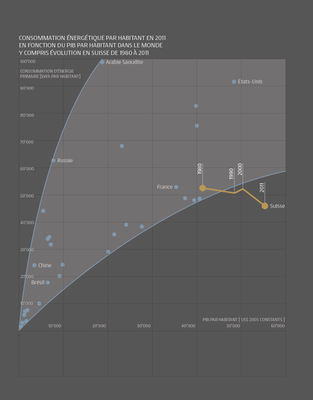What are the links between population, economic development and energy consumption?
In the absence of measures to improve energy efficiency, energy consumption increases with population and gross domestic product (GDP).
Population growth causes ipso facto a general increase in energy demand. To control energy consumption in times of population growth, there is only one solution: reduce individual consumption by means of efficiency measures.
Energy, like labour and capital, is also a factor of production. It can replace human labour through automation. Energy consumption is thus correlated with gross domestic product (GDP) [→ see figure below]. We can measure the energy needed to produce a unit of value (franc, euro, dollar, etc.) of GDP. This is called “energy intensity”, which is simply a country’s energy consumption divided by its GDP.
To reduce our energy consumption without compromising our prosperity, we will therefore have to reduce our energy intensity significantly through efficiency-enhancing measures: producing more with less energy. Switzerland's energy intensity has decreased by 30% over the past 30 years; it has increased its per capita GDP by 30% while reducing its per capita primary energy consumption by 15% [→ see figure below]. However, it is difficult to determine how much of this decline is the result of a real effort to improve energy efficiency in Switzerland or of the growing import of goods that require large amounts of energy to be produced abroad.
Energy intensity varies greatly from country to country, depending on its climate, geography and lifestyle, but also on its economic fabric. A high share of heavy industry leads to higher energy needs than a service-based economy. For example, China uses about double the energy of developed countries to produce one unit of value. But it exports a large proportion of its industrial products to countries, such as Switzerland, which have stopped producing them.
If we are realistic, we can expect a 1.8% annual improvement in energy intensity, which would amount to a decline of about 35% by 2035 at constant GDP. This would, in the long run, reduce our energy consumption while continuing economic development, in contrast to the trend since industrialisation began two centuries ago. Some measures, such as the energy-efficient retrofitting of buildings, can also increase GDP while reducing our consumption.

References
- Banque Mondiale (2019)
- Banque Mondiale (2019). GDP per capita. [ONLINE]. Available at: https://donnees.banquemondiale.org/indicator/NY.GDP.PCAP.CD?locale=null.
- International Energy Agency (IEA) (2018)
- International Energy Agency (IEA) (2018). Key world energy statistics 2018. OECD Publishing.
- Office fédéral de la statistique (OFS) (2019)
- Office fédéral de la statistique (OFS) (2019). Énergie: Consommation. [Online]. Available at: www.bfs.admin.ch/bfs/fr/home/statistiques/energie/consommation.html.
- Trialogue Energie Suisse (n.d.)
- Trialogue Energie Suisse (n.d.). Stratégie énergétique 2050.